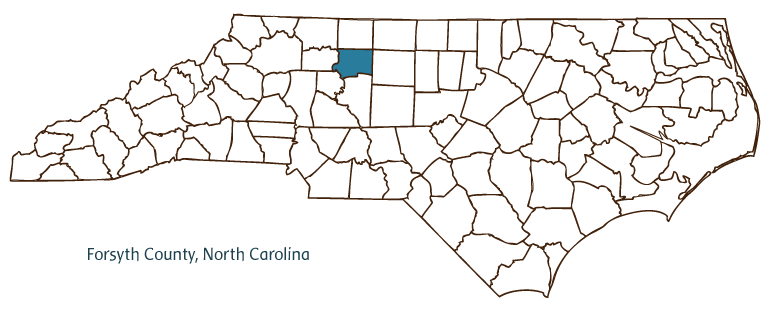Forsyth County Resources
- View All:
- Biographies
- Monuments
- locations
Copyright Notice: This article is from the Encyclopedia of North Carolina edited by William S. Powell. Copyright © 2006 by the University of North Carolina Press. Used by permission of the publisher. For personal use and not for further distribution. Please submit permission requests for other use directly to the publisher.

Forsyth County, located in North Carolina's Piedmont region, was formed from Stokes County in 1849 and took its name from Col. Benjamin Forsyth, a state legislator who fought and died in the War of 1812. The town of Winston, named after Revolutionary War veteran Maj. Joseph Winston, became the county seat in 1851; in 1913 it merged with its older neighbor Salem (a Moravian town named after the Hebrew word for peace) to form Winston-Salem. Other communities in the county include Kernersville, Clemmons, Lewisville, Tobaccoville, Walkertown, Rural Hall, Bethania, Bethabara, and Belews Creek.
The land that became Forsyth County was originally named Wachovia by the Moravians who purchased and settled it in 1753; the name was the Latin form of "Wachau," the Austrian ancestral estate of Moravian Church patron Count Nicholas Ludwig von Zinzendorf. Bethabara ("house of passage") was the first community established in the new land, although Salem (founded in 1766) emerged as the commercial hub of the Moravians' religious haven. Many elements of seventeenth- and eighteenth-century daily life in the town have been preserved in the Old Salem Historic District, which maintains more than 50 restored buildings and features a blacksmith, gunsmith, cobbler, and carpenter in period dress.
From its humble origins, Winston-Salem had emerged by the end of the twentieth century as Forsyth County's economic engine and the fifth-largest city in North Carolina (the county as a whole, with an estimated 321,000 residents in 2004, ranked fourth in population in the state). The city briefly, in 1920, held the title of North Carolina's largest city. In 1875 Richard Joshua Reynolds established his tobacco business in Winston, and the company's growth into one of the nation's largest corporations spurred the development of both the city and Forsyth County. In addition to R. J. Reynolds Corporation, other major businesses with Forsyth County roots include Krispy Kreme Doughnuts and the Wachovia Corporation (although the latter's corporate headquarters were relocated to Charlotte following its 2001 merger with First Union). Important agricultural and industrial products include tobacco, corn, soybeans, furniture, textiles, tractors, and optical fiber.
Winston-Salem, thanks in large part to the philanthropic pursuits of the Reynolds family and the local business community, is also regarded as a major cultural and artistic center in North Carolina. The Reynolds home, known as the Reynolda House, contains a major collection of American art. The city is home to the nation's first local arts council (the Arts Council of Winston-Salem and Forsyth County, established in 1949) as well as the first state-supported arts conservatory (the North Carolina School of the Arts, which opened in 1965). Salem College (1772), Wake Forest University (1834), and Winston-Salem State University (1897) are important academic institutes in the county. Celebrated Forsyth County cultural events include the Dixie Classic Fair, the National Black Theatre Festival (both in Winston-Salem), and the Christmas-themed Festival of Lights at Tanglewood Park (in Clemmons).
For an annotated history of the county's formation, with the laws affecting the county, boundary lines and changes, and other origin information, visit these references in The Formation of the North Carolina Counties (Corbitt, 2000), available online at North Carolina Digital Collections (note, there may be additional items of interest for the county not listed here):
County formation history: https://digital.ncdcr.gov/Documents/Detail/the-formation-of-the-north-ca...
Index entry for the county: https://digital.ncdcr.gov/Documents/Detail/the-formation-of-the-north-ca...
References:
Frank Tursi, Winston-Salem: A History (1994).
Additional resources:
Corbitt, David Leroy. 2000. The formation of the North Carolina counties, 1663-1943. https://digital.ncdcr.gov/Documents/Detail/the-formation-of-the-north-carolina-counties-1663-1943/3692099?item=4553233 (accessed June 20, 2017).
Digital Forsyth: https://www.digitalforsyth.org/
DigitalNC, Forsyth County: https://www.digitalnc.org/counties/forsyth-county/
Forsyth County Government: https://www.co.forsyth.nc.us/
Kernersville Chamber of Commerce: https://www.kernersvillenc.com/
Lewisville-Clemmon Chamber of Commerce: https://lewisville-clemmons.com/
Winston-Salem Chamber of Commerce: https://www.winstonsalem.com/
North Carolina Digital Collections (explore by place, time period, format): https://digital.ncdcr.gov
Image credits:
Rudersdorf, Amy. 2010. "NC County Maps." Government & Heritage Library, State Library of North Carolina.
Vocci, Robert Blair. "Forsyth County." NCpedia. State Library of NC. 2006. https://www.ncpedia.org/geography/forsyth.
FORSYTH COUNTY GOVERNMENT:
https://www.co.forsyth.nc.us/
COUNTY SEAT:Winston-Salem
FORMED: 1849
FORMED FROM: Stokes
LAND AREA: 408.15 square miles
2020 POPULATION ESTIMATE: 382,590
White: 66.6%
Black/African American: 27.5%
American Indian: 0.9%
Asian: 2.6%
Pacific Islander: 0.1%
Two or more races: 2.3%
Hispanic/Latino: 13.3% (of any race)
From State & County QuickFacts, US Census Bureau, 2020.
CONGRESSIONAL DISTRICT: 5TH
BIOGRAPHIES FOR![]()
Forsyth County
 WILDLIFE PROFILES FOR
WILDLIFE PROFILES FOR
Piedmont region
GEOGRAPHIC INFORMATION
REGION: Piedmont
RIVER BASIN: Cape Fear, Roanoke, Yadkin-Pee Dee, Map
NEIGHBORING COUNTIES: Davidson, Davie, Guilford, Stokes, Yadkin